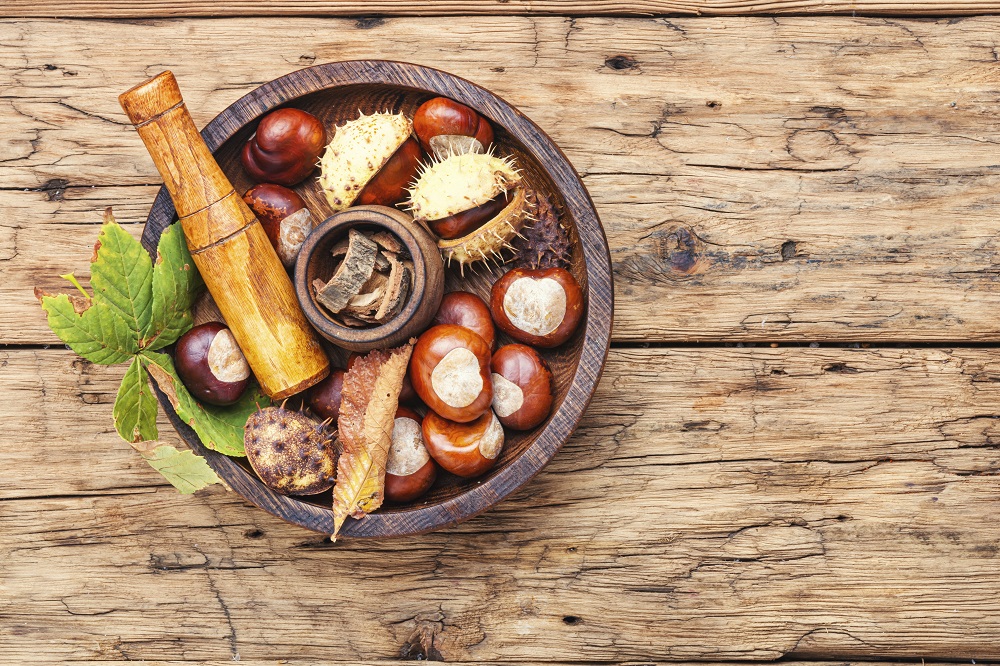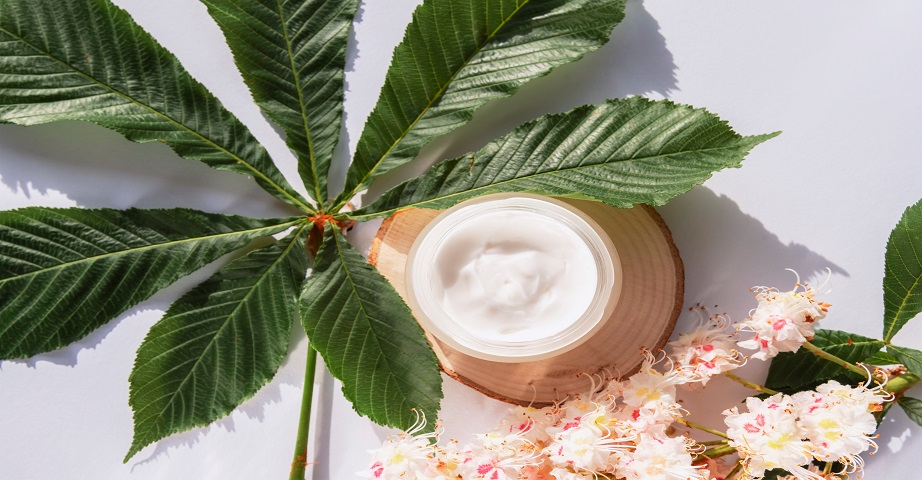Common horse chestnut - properties and purpose

The common horse chestnut is a park tree, which also often grows squares between blocks in urban agglomerations. The plant has a decorative function and protects against sunlight, and its seeds and fruits are willingly collected by children. But did you know that horse chestnut is also a raw material with pro-health properties, which is widely used in both phytotherapy and cosmetics?
What properties can exhibit the common horse chestnut? Is horse chestnut different from chestnut?
Common horse chestnut - description
Common horse chestnut (Aesculus hippocastanum L.), also known as horse chestnut, is a species of pubble tree of the Sapindaceae family. The plant can reach up to 25 meters in height and up to 2 meters in thickness. On thick shoots of horse chestnut grow large-sized folded leaves, the shape of which resembles a hand.
The common horse chestnut blooms in May - then it is sprinkled with white flowers, collected in dense and conical inflorescences. Then the fruit ripens and around September, on the tree appear brown seeds, enclosed in a green, spiky shell.
The horse chestnut come from the Balkan Peninsula. In the XVI and XVII centuries, during the Turkish expansion, it also spread in Europe, and now it is also grown on other continents. Horse chestnut is used primarily in urban areas, where the plant has an ornamental function and gives shade. In the past, the common horse chestnut seeds were used to produce glue and used as animal feed. Today, the plant, in addition to its decorative function, is also appreciated for its health-promoting properties. Moreover, the raw material is used for the production of cosmetics.
Common horse chestnut and edible chestnut
What is interesting, the common horse chestnut is not the same as the edible chestnut. Common horse chestnut seeds are called chestnuts, but the tree hidden under this name is a completely different plant than the horse chestnut.
The chestnut edible belongs to the Fagaceae family. It differs from the common horse chestnut primarily in the leaf structure - chestnut leaves are single and serrated on the edge. They look like beech leaves, although they are much larger. The chestnut seeds are edible, and the tree itself is not popular in Poland, because it is too cold for it in the country.
Recommended products
Active substances in common horse chestnut
In natural medicine, phytotherapy and cosmetics, almost all parts of the common horse chestnut are used - both its seeds and fruits, as well as flowers, leaves and bark. The plant is very popular due to the content of active compounds. What substances can be found in the horse chestnut?
- Triterpene saponins, the most important compound of which is escin, a mixture of at least 30 different saponins,
- flavonoids,
- coumarins - esculin, or coumarin from horse chestnut bark, deserves special attention,
- tannins,
- phenolic acids,
- sugars,
- starches,
- carotenoids,
- sterols,
- mineral compounds,
- essential oils.
In phytotherapy and the cosmetic industry, flowers and horse chestnut bark are most often used due to their composition and high concentration of valuable substances. The least commonly used ingredient is the leaves of the plant.
Properties of common horse chestnut
The common horse chestnut may have anti-inflammatory, antibacterial and diastolic properties. The plant can strengthen and seal blood vessels. Escin, a mixture of saponins from horse chestnut seed, can inhibit the activity of enzymes that destroy the walls of capillaries, and in addition, the compound can increase the resistance of vessels, improve their elasticity and seal them.
The active substances contained in common horse chestnut can also support normal blood flow. The compounds can thin the blood and reduce its stickiness and delay the clotting process. Thus, they can reduce the risk of blood clots and can improve the blood supply to all organs.
The active compounds present in common horse chestnut extract can also inhibit the formation of oedema and moderate already occurring haematomas and damage. In addition, they can reduce pain, have an astringent effect and help reduce the effects of burns, frostbite or other skin damage.
The anti-swelling properties of horse chestnut can also be used to help in combating cellulite. Extracts from the plant can improve microcirculation and seal blood vessels, as well as facilitate the removal of toxins from the subcutaneous tissue, while contributing to the reduction of cellulite.
Horse chestnut can also support the relief of digestive problems - tannins and other active compounds present in the plant can have a diastolic, antibacterial and anti-inflammatory effect, supporting the proper functioning of the digestive system.
The use of horse chestnut
Extracts and preparations of common horse chestnut are often used in the treatment of many diseases. The horse chestnut can be helpful during the occurrence of swelling or haematomas, as well as in the case of bruises, frostbite or burns. Extracts from the plant can relieve tendon inflammation and protect blood vessels from damage. They can also be a support in the treatment of haemorrhoids or venous clots.
The horse chestnut is also used in cosmetics, among others as an ingredient in anti-cellulite lotions and creams. In addition, the plant can be helpful in the care of couperose and mature skin - the raw material can increase skin tone and narrow pores, as well as reduce the visibility of dilated vessels.
In addition, the common horse chestnut can be used as:
- melliferous plant,
- dye for wool - bark and fruit shells can be used in tanning to color wool,
- glue ingredient,
- animal feed - starch-rich seeds are used as an ingredient of animal food,
- washing agent and foaming product for fire extinguishers - powdered chestnut seeds are used for this purpose,
- black paint - fruit covers, after burning, can give a paint with a dark color.
- 100 g of common horse chestnut flowers,
- 500 ml of spirit.

How to prepare an infusion of horse chestnut?
The infusion of common horse chestnut can be prepared on its own. Just one spoon of dried plant flowers pour a glass of boiling water and brew under cover for 20 minutes.
The infusion, or rather a decoction, can also be prepared from the bark of horse chestnut - then one spoon of ground bark should be poured with a glass of boiling water and such a mixture should be cooked before 5 minutes. Next, the liquid should be removed from the fire, set aside to cool for half an hour and strain.
How to prepare a tincture of horse chestnut?
To prepare a tincture of common horse chestnut you need:
The flowers should be poured with alcohol and left in a dark and cool place for at least a week. After 7 days, the mixture should be strained. The tincture can be used both externally, to rub swelling or varicose veins, as well as orally.
Side effects and contraindications to the use of horse chestnut
Undesirable symptoms after using horse chestnut are rare. Sometimes the plant extract may contribute to disruption of the digestive system and symptoms such as nausea, vomiting or diarrhea. The horse chestnut may also contribute to an allergic reaction.
Horse chestnut preparations should not be used by people suffering from acute kidney failure. Caution should also be maintained by people taking various drugs - horse chestnut extract may weaken or intensify the effect of some pharmaceuticals, and may also be toxic in combination with other preparations. Therefore, the horse chestnut should not be combined with anticoagulants or medicines containing cephalosporin. It may also be dangerous to take horse chestnut along with aminoglycoside antibiotics.

